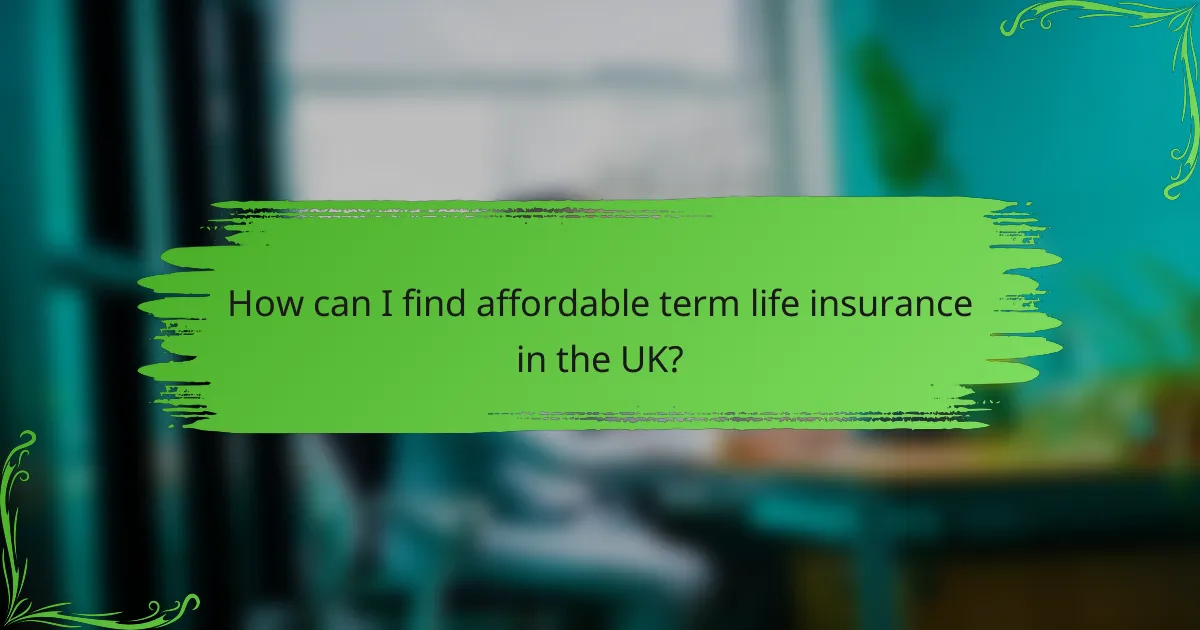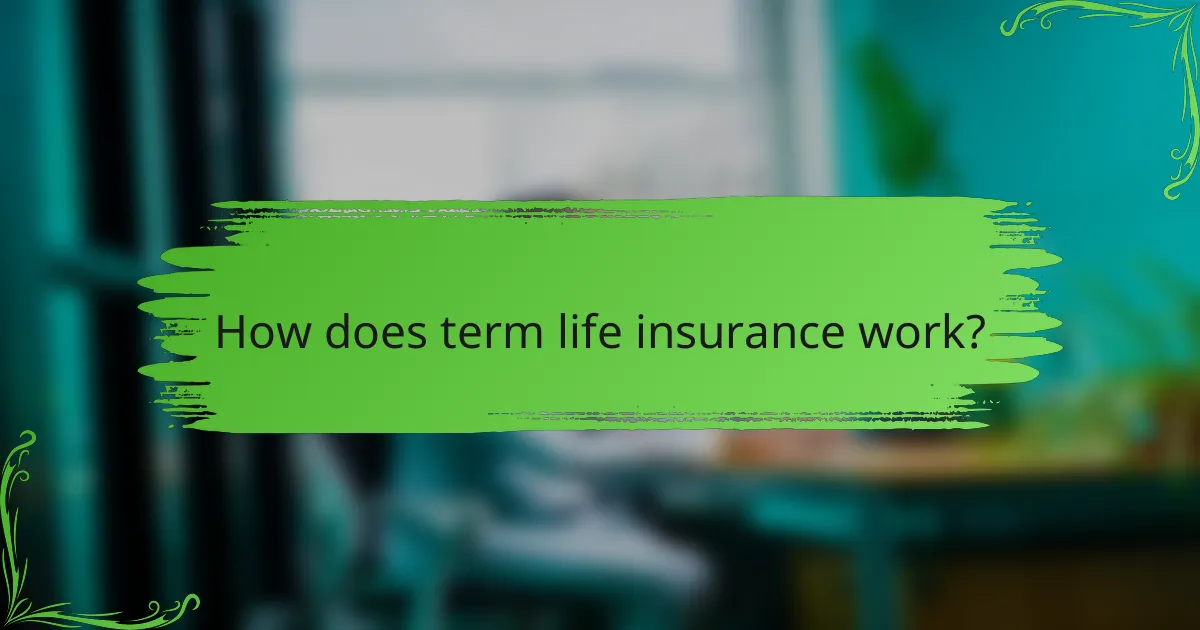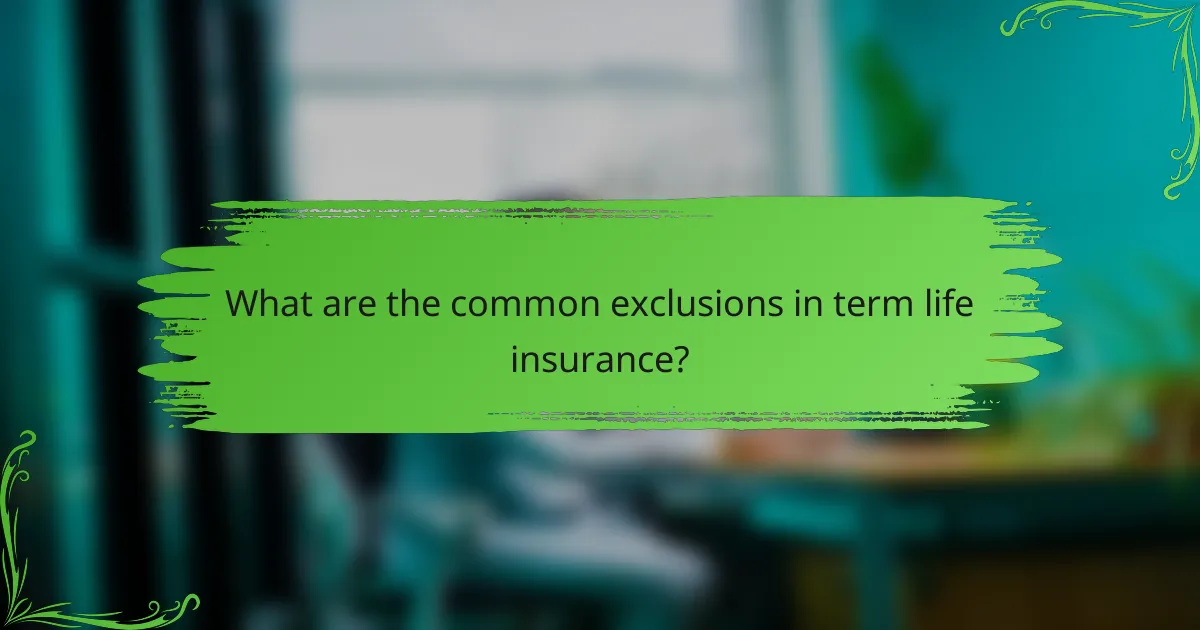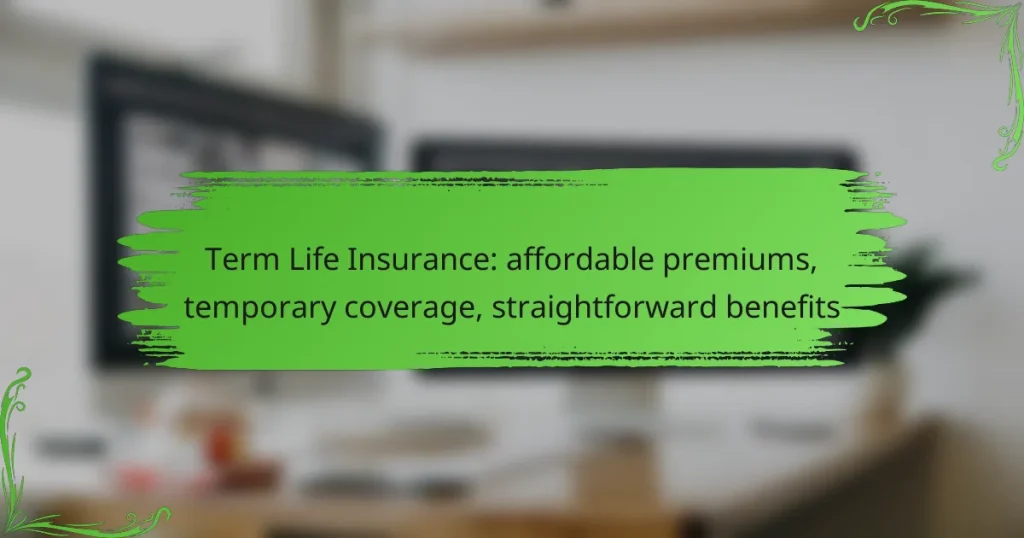Term life insurance is an accessible option for those seeking affordable premiums and temporary coverage tailored to their specific needs. With straightforward benefits, it provides financial protection for a designated period, ensuring peace of mind for policyholders and their beneficiaries. By comparing quotes and understanding the terms, individuals can find the right policy to suit their circumstances.

How can I find affordable term life insurance in the UK?
To find affordable term life insurance in the UK, start by comparing quotes from various providers and considering your coverage needs. Look for policies that offer competitive premiums and straightforward benefits, ensuring you understand the terms and conditions before making a decision.
Comparison websites like MoneySuperMarket
Comparison websites such as MoneySuperMarket allow you to quickly evaluate different term life insurance policies side by side. By entering your details, you can receive tailored quotes from multiple insurers, helping you identify the most affordable options available.
When using these platforms, pay attention to the coverage amounts, policy lengths, and any exclusions that may apply. This will help you make an informed decision based on your specific needs and budget.
Direct quotes from providers like Aviva
Obtaining direct quotes from providers such as Aviva can give you a clearer picture of the premiums you might expect to pay. Many insurers offer online calculators that allow you to input your age, health status, and desired coverage to receive an instant quote.
It’s advisable to compare these direct quotes with those from comparison sites to ensure you are getting the best deal. Additionally, consider contacting providers directly to inquire about any discounts or special offers that may not be listed online.

What are the benefits of term life insurance?
Term life insurance offers several advantages, including affordable premiums, temporary coverage tailored to specific needs, and straightforward benefits that make it easy to understand. This type of insurance is designed to provide financial protection for a designated period, making it suitable for those seeking coverage for a limited time.
Temporary coverage for specific needs
Term life insurance is ideal for individuals who need coverage for a specific duration, such as when raising children or paying off a mortgage. Policies typically range from 10 to 30 years, allowing you to align the coverage period with your financial obligations.
When selecting a term length, consider your current and future financial responsibilities. For example, if you have young children, a 20-year term might provide peace of mind until they become financially independent.
Lower premiums compared to whole life insurance
One of the most significant advantages of term life insurance is its lower premiums compared to whole life insurance. Because term policies do not accumulate cash value and only provide coverage for a limited time, they are generally more affordable, often costing a fraction of whole life premiums.
For instance, a healthy 30-year-old might pay around $20 to $30 per month for a $500,000 term policy, while a whole life policy for the same amount could exceed $300 monthly. This cost-effectiveness makes term life insurance an attractive option for budget-conscious individuals.

How does term life insurance work?
Term life insurance provides temporary coverage for a specified period, typically ranging from 10 to 30 years. During this time, policyholders pay fixed premiums in exchange for a guaranteed death benefit to their beneficiaries if they pass away within the term.
Fixed coverage amount for a set term
With term life insurance, you choose a fixed coverage amount, which is the sum paid to beneficiaries upon the insured’s death. This amount is determined at the policy’s inception and remains constant throughout the term. Common coverage amounts can range from $100,000 to several million dollars, depending on individual needs and financial obligations.
It’s essential to assess your financial responsibilities, such as mortgage payments, education costs, and other debts, to determine an appropriate coverage amount. A higher coverage amount typically results in higher premiums, so balance your needs with your budget.
Payout to beneficiaries upon death during the term
If the insured individual passes away during the term of the policy, the designated beneficiaries receive the agreed-upon death benefit. This payout is generally tax-free and can be used to cover living expenses, debts, or any other financial needs the beneficiaries may have. It’s crucial to keep beneficiary information updated to ensure the funds go to the intended recipients.
Be aware that if the insured outlives the term, the policy expires without any payout, and no benefits are returned. Some policies offer a conversion option, allowing you to switch to a permanent life insurance policy before the term ends, which can be a valuable feature if your needs change.

What factors affect term life insurance premiums?
Term life insurance premiums are influenced by several key factors, primarily age, health status, coverage amount, and term length. Understanding these elements can help you make informed decisions when selecting a policy that fits your needs and budget.
Age and health status
Your age and health status are critical determinants of your term life insurance premiums. Generally, younger individuals with fewer health issues will pay lower premiums compared to older applicants or those with pre-existing conditions. Insurers often assess your medical history, lifestyle choices, and any chronic illnesses when calculating rates.
For example, a 30-year-old non-smoker in good health may find premiums in the low tens of dollars per month, while a 50-year-old smoker with health concerns could face rates that are significantly higher. It’s essential to maintain a healthy lifestyle to secure more affordable premiums.
Coverage amount and term length
The amount of coverage you choose and the length of the term will directly impact your premiums. Higher coverage amounts typically result in higher premiums, as the insurer’s risk increases. Similarly, longer term lengths can lead to increased costs since the policy is in effect for a more extended period.
For instance, opting for a $500,000 policy for a 20-year term may cost more than a $250,000 policy for a 10-year term. When selecting coverage, consider your financial obligations and how long you need the coverage to protect your loved ones adequately.

What are the common exclusions in term life insurance?
Common exclusions in term life insurance typically include specific circumstances under which the policy will not pay out. Understanding these exclusions is crucial for policyholders to ensure they are adequately covered and to avoid surprises during a claim.
Suicide within the first two years
Many term life insurance policies include a clause that excludes coverage for suicide if it occurs within the first two years of the policy. This period is often referred to as the “suicide clause,” and it aims to prevent individuals from purchasing insurance with the intent to commit suicide shortly thereafter.
If a policyholder dies by suicide after the two-year mark, the beneficiaries are usually entitled to the full death benefit. It’s essential to review the specific terms of your policy, as this timeframe can vary by insurer.
Death due to risky activities
Term life insurance may exclude coverage for deaths resulting from risky activities, such as extreme sports, skydiving, or other hazardous pursuits. Insurers often classify these activities as high-risk and may require additional premiums or riders to cover them.
Before engaging in any high-risk activities, it’s advisable to inform your insurer and understand how these activities could affect your coverage. Failing to disclose such information might lead to a denial of claims related to injuries or fatalities incurred during these activities.

How do I choose the right term length?
Choosing the right term length for your term life insurance depends on your financial obligations and future life changes. Generally, term lengths can range from 10 to 30 years, so consider how long you need coverage based on your current and anticipated needs.
Assessing financial obligations and dependents
Start by evaluating your current financial responsibilities, such as mortgage payments, education costs for children, and daily living expenses. If you have dependents who rely on your income, ensure the term length covers their needs until they become financially independent. For example, if your children are young, a 20 to 30-year term may be appropriate to provide security until they finish college.
Consider the total amount of debt you have and how long it will take to pay it off. If you have significant obligations, a longer term may be necessary to ensure that your loved ones are protected during that period.
Considering future life changes
Think about potential life changes that could affect your insurance needs, such as marriage, having children, or changes in employment. For instance, if you plan to expand your family in the near future, a longer term may be beneficial to cover additional financial responsibilities.
Also, consider your retirement plans. If you anticipate being debt-free or having fewer financial obligations by a certain age, you might opt for a shorter term. A common approach is to align your term length with milestones, like the duration of your mortgage or until your children reach adulthood.

What are the alternatives to term life insurance?
Alternatives to term life insurance include whole life insurance, universal life insurance, and accidental death insurance. Each option offers different features, coverage durations, and premium structures, catering to various financial needs and preferences.
Whole life insurance
Whole life insurance provides coverage for the insured’s entire lifetime, as long as premiums are paid. This type of policy combines a death benefit with a cash value component that grows over time, offering both protection and a savings element.
Premiums for whole life insurance are generally higher than those for term policies, often ranging from several hundred to thousands of dollars annually, depending on the insured’s age and health. This higher cost is due to the lifelong coverage and cash value accumulation.
Universal life insurance
Universal life insurance is a flexible permanent policy that allows policyholders to adjust their premiums and death benefits. It includes a cash value component that earns interest, which can be used to pay premiums or increase the death benefit.
This type of insurance can be more affordable than whole life, with premiums varying widely based on the chosen coverage and the insurer’s terms. It’s essential to review the policy’s interest rates and fees, as these can impact the cash value growth.
Accidental death insurance
Accidental death insurance provides coverage specifically for deaths resulting from accidents. It typically has lower premiums compared to term life insurance, making it an attractive option for those seeking affordable coverage.
However, this policy does not cover deaths from natural causes or illnesses, which limits its overall protection. It’s best suited for individuals looking for supplemental coverage or those in high-risk occupations.


